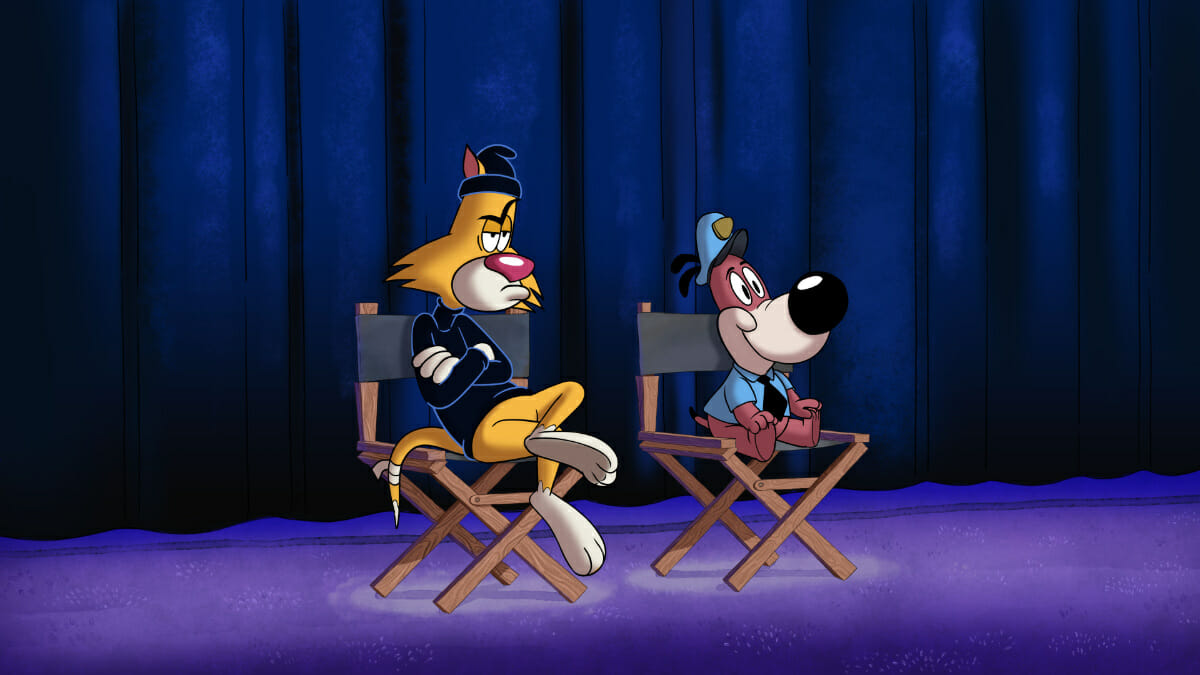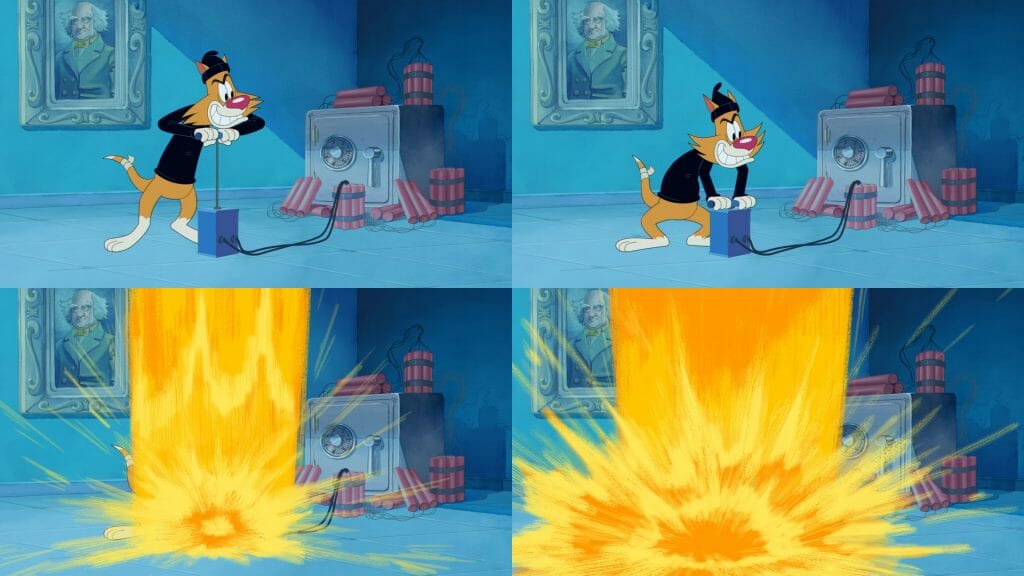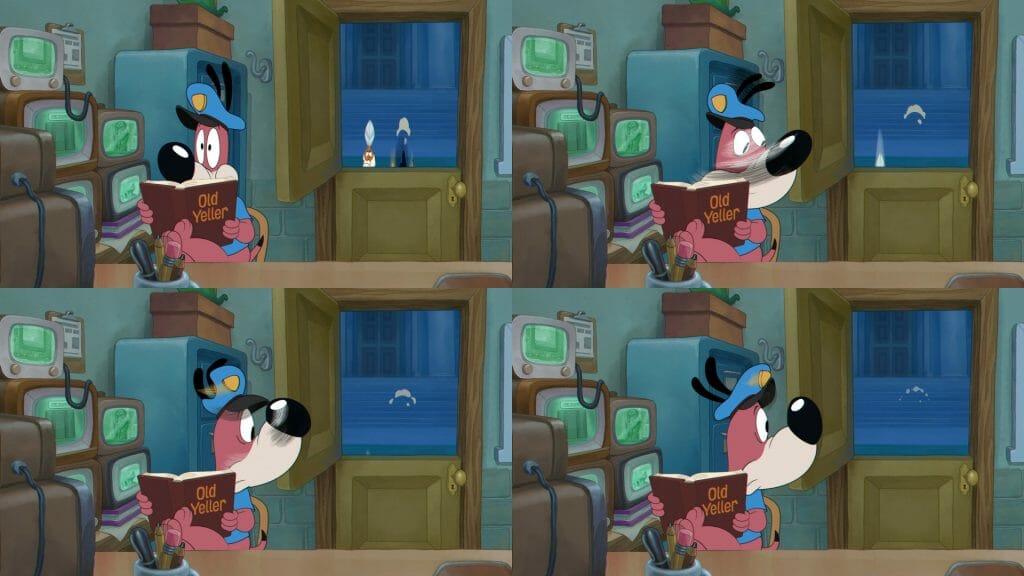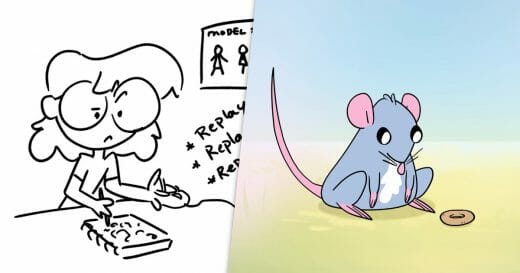
Cat Burglar is an interactive special on Netflix, featuring a slapstick style that harkens back to Tex Avery’s animated shorts. The special puts the viewer in the hot seat, answering trivia questions to help Rowdy the cat bag up prized paintings, evade Peanut the the security dog and make off into the night by a whisker! The show was born from the mind of Charlie Brooker (Black Mirror), developed by Netflix Animation and animated by the talented team at Boulder Media.
We were fortunate enough to speak with Gillian Comerford, Creative Director at Boulder Media, who let the cat out of the bag about the show’s production process. Gillian talks us through collaborating with Netflix and the writing team, how they used Toon Boom Harmony to create character rigs for the animation team, and staying true to the spirit of vintage cartoons.
What can you tell our viewers about the premise of your interactive special, and its characters?
Gillian: It’s an Animated interactive quiz, starring Rowdy, our Cat Burglar, and Peanut, a security guard Dog. Rowdy is on a quest to steal paintings locked away in the basement of a prestigious museum while Peanut’s job is to go out of his way to stop him.
Throughout the game we see the various outcomes of this pair’s antics. Every few minutes, questions flash up that you have to answer with your remote, like a pub trivia quiz. Getting them right or wrong affects the outcome. So you control the luck of the character, rather than the decisions they’re making.
Were there any influences on Cat Burglar’s retro style?
Gillian: It was all based around the 1940s classic slapstick style of Tex Avery. Looney Tunes, Droopy Dog and Tom and Jerry — you can really see the influences when you see Rowdy and Peanut beside some of these classic characters. What these cartoons did so well was breaking characters out of their regular body posing for over-the-top expressions and poses.
The backgrounds all took on a beautiful painterly feel. Again, to mirror the old-fashioned techniques and keep that lovely organic feel to the environments. All animation and FX had to be timed on twos, although at times you might find the odd few frames on ones where the action was so fast that we had to cheat for the movements to read fully! Dry brush smears were added to faster movements.
When we got to compositing, we had to think about the cell animation process and how best to make this look authentic. Nothing could feel bright, new and shiny. Softening the animation, adding shadows where we felt a cell might be visible, adding grain, blur and chromatic aberration.
The music also played a key role in creating the feel of the vintage cartoon. There is little to no dialogue, for the most part. Kind of like a silent movie, where the actions and expressions, along with the music cues and sound effects, play such an important part of the piece.

How did you approach character design with this in mind?
Gillian: The character design and pose sheets were handled by Netflix before it came to Boulder. They provided turnarounds for the two main characters along with special pose sheets. These are sketches with the extremities of expression and posing that the creators and directors wanted to achieve.
We could really see from here how far we could push the animation, which was really fun to go to these lengths with a rigged character. We worked part rig, part frame-by-frame, as some of the movements were so outrageous that you had to completely break away from the rig.
How did you achieve your stylistic choices using Toon Boom Harmony?
Gillian: With our incredible rig team, we were able to create very malleable rigs for our animation team. They could bend and stretch to extremes we had not gone to before. We were also able to create various brushes within Toon Boom Harmony to replicate the dry brush smears and strokes, which was key to unlocking how the old paint brush smears on very fast motions originally looked. The animation was all composited in Harmony.

What was your experience with interactive stories, prior to developing Cat Burglar?
Gillian: None at all, prior to Cat Burglar landing. We were aware of the growing popularity of interactive media, but we had never worked with it before in Boulder.
Black Mirror: Bandersnatch was referenced most when we were briefed on Cat Burglar. But it was the creators’ first time experimenting with Animation and Interactive quiz together.
We were all learning throughout the whole process. Some problems arose sooner, others later but you never knew what might crop up. Until it did, then we would be working together to figure it out!
What are the biggest challenges and opportunities presented by the interactive format?
Gillian: Trying to explain the interactivity to the team was tricky. We did this entire project during Covid-19, so we were not able to be with the crew and work together in that way. It was the ‘non-interactive, interactive’ show in some ways. Where something that would be so easy to explain when you’re in the studio together is much trickier over a screen share. But we got there. A lot of the team had worked together for years so there was a good understanding of what was expected. And we all really loved the show, or game, whatever way you look at it.
Everything is laid out as Levels and Sequences rather than Episodes and Scenes. We had an Intro, Tutorial, Levels 1-6, Bridge, Levels 8-11. Each Level would play through until you came to your Choice Point, where you have to answer the trivia question. If you get it correct, you move along in the game. Get it wrong and you lose a life.
These Choice Point segments had to be seamless transitions from the question to the answer, where there was no camera change. So there is no room for error. Everything has to align perfectly from background placement to the frames the animation and FX are on. The shots can get very long because essentially you need a flawless join. They need to be animated together, so the file sizes could get very heavy.
We dealt with only two characters most of the time for these sections. We are thankful; it could have been more difficult!

Were there creative choices that you would not have been able to make in a linear format?
Gillian: Funnily enough, it was almost the opposite. Because there was a strict structure to Cat Burglar, each scene needed to lead onto the next exactly. The creative choices really fell to how we could be as loyal as possible to the vintage cartoons in every other aspect of the show. Doing the research and development there really was the fun part.
How did you manage workflow, with so many alternate scenes and endings?
Gillian: In gameplay, you see between 5-15 minutes of animation. But when you add up the amount of animation produced for the entire game, it comes in at over an hour of animation, made up of a few hundred clips. So, we planned it out as best we could to mirror our normal workflow and schedules. Balancing each level to around 10 minutes each to replicate an episode of normal animation.
The same experienced animator and compositor would have to be assigned the Choice Points, so there were no complications in these areas. But there are always complications and working in a format you’re not used to. But you get there, and it seems like second nature after that!
Do you have advice for other artists who are considering interactive animation?
Gillian: Don’t do it!
Just kidding. Plan everything out carefully. Create maps of the levels and how they run into each other, so it is visually clear how it is going to work for everyone, outside of what you are thinking. The clearer the plan from the beginning, the easier it will be to follow for the teams later. We unfortunately didn’t have that map for Cat Burglar, but in hindsight it would have solved some of the questions at an earlier stage.
Any final acknowledgements or shout-outs?
Gillian: Huge thanks to Mike Hollingsworth (writer, director, producer) and James Bowman (director) who I worked with quite closely. They trusted the Boulder team with a project that was very important to them. Annabelle Jones and Charlie Brooker (creators and executive producers), for giving us this opportunity at Boulder Media.
Our crew learned so much with this being a new format for the studio. Being able to touch on the classic 1940’s style of animation in a different way was very exciting for us. It was a fantastic opportunity.
- Curious to watch the interactive special? You can steal a peek at Cat Burglar on Netflix.
- For more incredible work from Boulder Media, be sure to visit the studio’s website and look for opportunities to join their crew.


